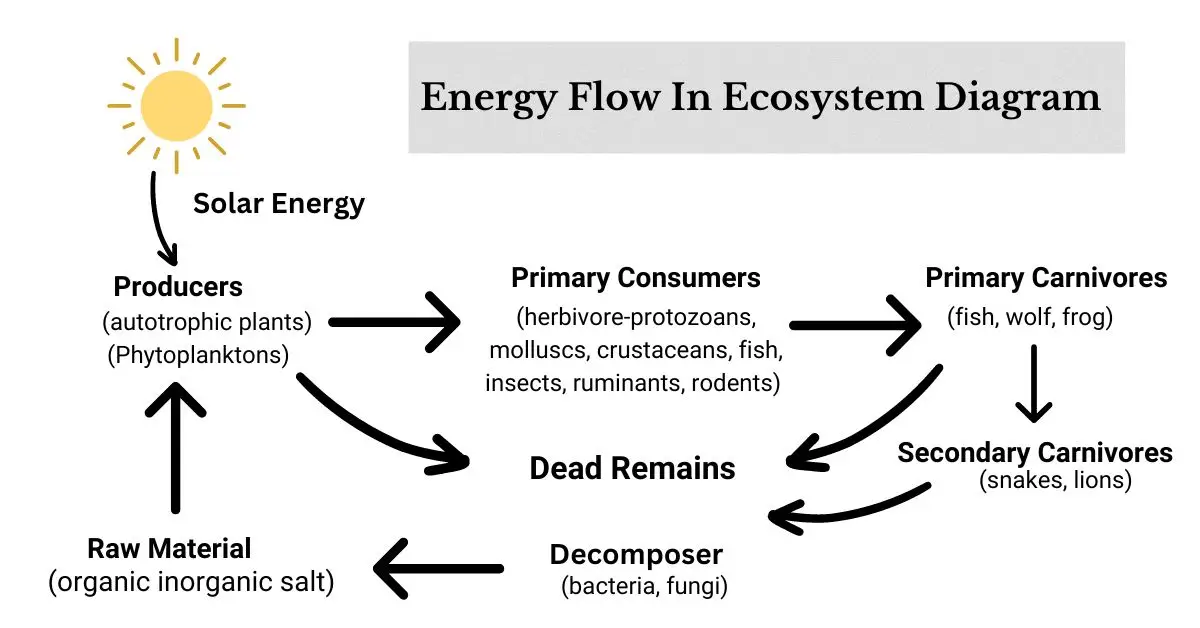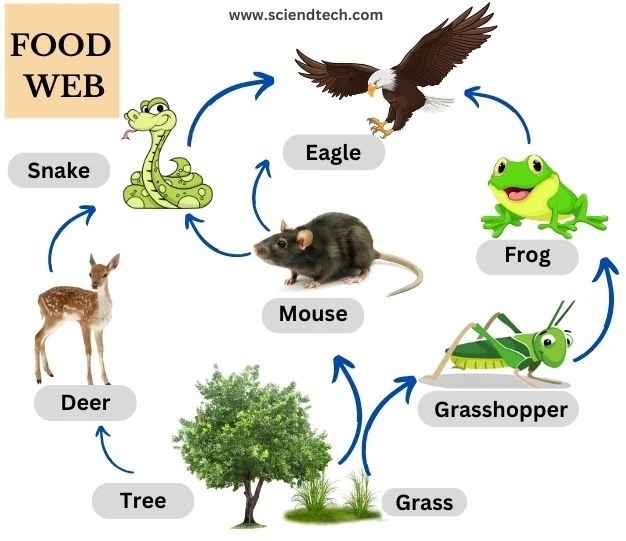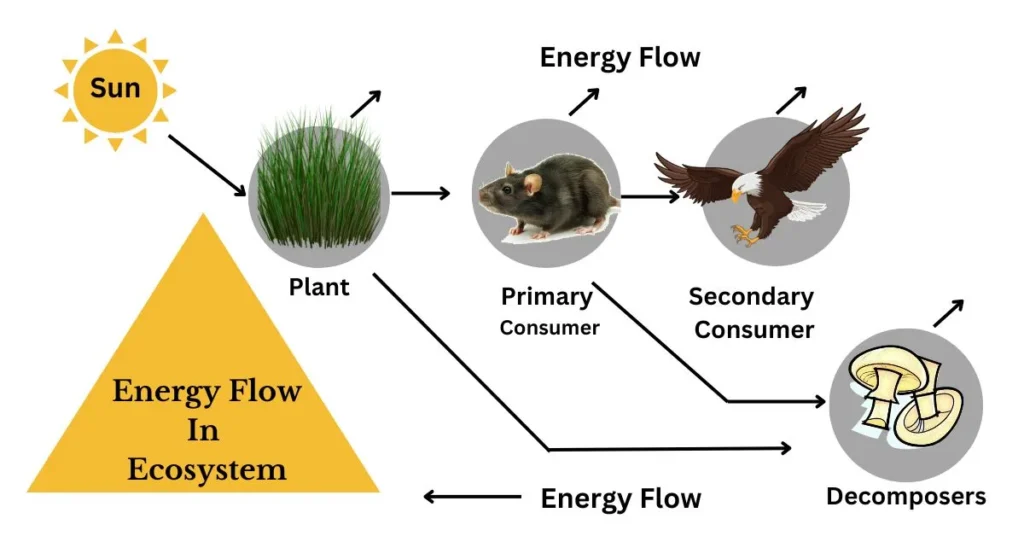In this article we will explain energy flow in ecosystem, with the help of diagrams. What are it’s steps, different energy flow models and Biogeochemical cycles.
Imagine you’re in a beautiful forest, the sun shines bright, providing energy for all living things. The plants in the forest are the producers which use the sun’s energy to make their own food, which helps them grow and stay healthy.
Now, in the forest there are also Deer, who eat the plants. The plants are their source of energy, giving them the strength to move around. But there are foxes in the forest too! The fox is a predator, meaning it eats other animals which means it depends on the energy from the Deer to survive.
Living things depend on each other for energy to survive. The sun helps the plants, plants give energy to the Deer, Deer give energy to the Fox and so on. This is possible because of the flow of energy in this ecosystem. But how does this happen? Let’s see.
What is energy flow in ecosystem
Energy flow in ecosystem is the transfer of energy in a food chain from one living organism to another within an ecosystem. Every step of a food chain is known as a trophic level. The flow of energy to the trophic levels is governed by two laws of thermodynamics.
Law of Thermodynamics
First Law Of Thermodynamics – According to the First Law of Thermodynamics, energy cannot be made or destroyed. Instead, it can only change from one form to another or be transferred from one part of the system to another.
Second Law Of Thermodynamics – Second Law Of Thermodynamics states that some of the energy used in the transformation is lost as heat energy and released into the environment.
Related Post : In Situ And Ex Situ Conservation Of Biodiversity
Explain Energy Flow In Ecosystem
The main energy source for almost all living things on Earth is sunlight. Less than 50 per cent of the sun’s effective radiation reaches Earth. Out of the 40-50 per cent we receive, plants use 2-10 per cent for photosynthesis.
All living organisms are divided into producers and consumers. Plants are the primary producers. The Chloroplasts in plants contain a green pigment chlorophyll which absorbs the energy from the sun.
Plants use this energy to convert carbon dioxide and water into glucose and oxygen through a process called photosynthesis. This process acts as the primary source of energy for the whole ecosystem.
Organisms that obtain energy by consuming other living organisms are called consumers. Some organisms feed on plants for energy known as Herbivores, others consume herbivores for energy called as Carnivores and others consume both plants and animals called Omnivores.
Those organisms that feed on dead, decaying animals are called Decomposers. They secrete enzymes that break down dead plants and animals into smaller molecules, and nutrients like nitrogen and phosphorus.
Decomposers release these nutrients back into the soil, making them available for uptake by plants. This nutrient recycling is important for the growth and health of primary producers (plants) and other living organisms within the ecosystem.
You May Also Like : In Situ And Ex Situ Conservation Of Biodiversity
Steps Of Energy Flow In Ecosystem
1) The process of energy flow in an ecosystem starts with the primary producers, which are green plants and algae. They capture energy from the sun and convert it into chemical energy in the form of glucose.
2) At the second step, the energy is transferred to the primary consumers, also known as herbivores. They eat plants and obtain energy from the glucose and other nutrients stored in plants for metabolic processes like breathing, and digestion.
3) At third step the energy is passed on to secondary consumers, which are carnivores that prey on herbivores to get energy.
4) Further, there may be tertiary consumers, also known as top predators. These carnivores feed on other carnivores, and they occupy the highest trophic level in the food chain.
5) The final step in energy flow through an ecosystem involves decomposers, such as bacteria and fungi. They break down dead organic matter, releasing nutrients back into the ecosystem and recycling nutrients making them available for primary producers.
Energy Flow In Ecosystem Diagram

Trophic level
A trophic level is a step or position in the food chain or food web. It represents the flow of energy in an ecosystem.
Throughout the transfer of energy to each trophic level, a portion of the energy is used by each organism for its metabolic processes, growth, and reproduction. As a result not all the energy from one trophic level is passed on to the next level since much of the energy is lost as heat and waste during these processes.
The flow of energy in a food chain follows the 10 percent law. According to this law, only 10 percent of energy flows from one trophic level to the next, the remaining 90 percent is lost to the atmosphere.
Primary Producers are present on the first trophic level. They are autotrophs, meaning they can produce their own food using energy from the sun through photosynthesis.
Primary Consumers (Herbivores) are present on the second trophic level that directly consume the primary producers for energy.
Secondary Consumers (Carnivores) are present on the third trophic level that eat herbivores for energy.
Tertiary Consumers (Top Carnivores) are present on the fourth and last trophic level. They consume other carnivores for energy.
Food Chain
A food chain is a simple and straightforward representation of the flow of food energy in an ecosystem. It starts with autotrophs which are eaten by herbivores. Herbivores are eaten by carnivores and carnivores are consumed by top carnivores.

As discussed above each nutrient level in the food chain is known as Trophic level.
Food chains are usually connected to complex food webs that show the complex relationships between different organisms and trophic levels.
There are three main types of food chains based on the primary source of energy –
Grazing Food Chain – This type of food chain starts with green plants as their main source of energy.
Detritus Food Chain – In the detritus food chain, the primary source of energy comes from dead organic matter, known as detritus.
Parasitic Food Chain – The parasitic food chain involves parasites that obtain their energy and nutrients from a host organism. Eg: The tick obtains its energy from the deer’s blood.
Food Web
A food web is represented by interrelated food chains overlapping and intersecting each other, forming a network of interdependent relationships among producers, consumers, and decomposers. It shows the multiple pathways for energy flow in an ecosystem.

For ex: As shown in above diagram, plants are eaten by many herbivores such as Grasshopper, Deer and Mouse for energy. Similarly, Deer and Mouse is eaten by a Snake whereas Grasshopper is eaten by a Frog to obtain energy. Furthermore, Eagle which is a top carnivore consumes both herbivore (mouse) and other carnivores (Snake and Frog) to get energy.
We can see a single carnivore may consume different types of herbivores, and those herbivores, in turn, may consume various plant species. Additionally, some organisms can have many roles, serving as both predator and prey at different times.
Ecological Pyramids
Ecological pyramids are graphical representations that show us the distribution of energy, biomass, or number of individuals at each trophic level. The pyramid’s base represents the primary producers, and each level above represents the successive trophic levels.
The three different Ecological Pyramids are –
Pyramid of Energy – it represents the amount of energy available at each trophic level in the ecosystem. As we move up the pyramid, the amount of energy decreases at higher trophic levels because energy is lost as heat and metabolic waste.
Pyramid of Biomass – it shows the total mass of living organisms at each trophic level. Higher trophic levels see a decrease in biomass because only a portion of the energy available at one level passes on to the next level.
Pyramid of Numbers – it represents the number of individuals at each trophic level in the food chain. The number of individuals often decreases as we move up the pyramid.
Is Energy Flow In Ecosystem Unidirectional Or Bidirectional
Energy flow in ecosystem is unidirectional. It follows a one-way path from the primary producers at the start of the food chain to the various levels of consumers and finally to decomposers.
This is because as energy moves up the food chain, it undergoes losses at each transfer in the form of heat and other metabolic processes, that’s why it cannot be reused at other stages. This is the reason why energy flow in ecosystem is always unidirectional.
Energy flow model
An energy flow model is a simplified representation or diagram of a food chain model that illustrates the movement of energy through an ecosystem. For a better understanding of how energy flows in ecosystem there are three types of energy flow model.
Y Shaped Energy Flow Model
Y shaped energy flow model also known as 2-channel energy flow model represents the energy flow in both terrestrial and aquatic ecosystems.
It consists of two arms, each representing distinct food chains, one arm shows the herbivore food chain, and the other arm shows the decomposer (detritus) food chain. The primary producers (green plants) at the base of each arm are entirely different.
This model shows that, under natural conditions, the two food chains are not fully isolated from one another but are interconnected and affect each other.
The Y-shaped energy flow model sticks to the basic stratified structure of an ecosystem, where different trophic levels interact with each other.
The micro and macro consumers in this model differ a lot in size and metabolic relationships, showcasing the diversity of organisms that play important roles in energy flow in ecosystem.
Single Channel Energy Flow Model
The Single channel energy flow model represents the unidirectional flow of energy. The energy that green plants get through photosynthesis does not return to the original source (the sun), but rather flows through different trophic levels, irrelevant to the lower level.
At every trophic level, there is a constant loss in energy. Therefore the more shorter food chains are, more will be the available amount of food energy.
Universal Energy Flow Model
The Universal energy flow model provides useful details about the nature of energy flow in ecosystems. This model has large use since it may be used to understand the energy dynamics of many living things, such as individuals, populations, trophic groups, plants, animals, microorganisms, and more.
This model is shown in a series of interconnected boxes to show the flow of energy and biomass within an ecosystem. Additionally, the model includes a crucial box for decomposers responsible for breaking down dead organic matter and recycling nutrients.
A key component of this model is the breaking down of the assimilation energy (A) in respiration (R) and production (P). P stands for the fraction that is transformed into new or different organic matter and is made available to the following trophic level.
As an example, feces, the non-assimilated component (NU – not utilized) also enters the detritus food chain simultaneously.
Biogeochemical Cycles
Biogeochemical cycles, also known as nutrient cycles, are essential processes that involve the cycling and recycling of elements and compounds within Earth’s ecosystems. The Biogeochemical cycle affects the amount and form of energy available to different organisms and the overall functioning of the ecosystem.
There are five types of biogeochemical cycles –
Carbon Cycle – the carbon cycle involves the movement of carbon between the atmosphere, living organisms, and soil. When an organism dies out, decomposers break down its remains and release carbon dioxide. This process completes the cycle, as the carbon is once again available for photosynthesis by plants.
Nitrogen Cycle – it involves the conversion of nitrogen gas in the atmosphere into forms usable by living organisms, such as ammonia and nitrates. These nitrogen compounds are then available for uptake by plants to incorporate nitrogen into their tissues, and when consumed by consumers, it becomes part of their bodies.
Phosphorus Cycle – it involves the movement of phosphorus through rocks, soil, water, and living organisms. The degradation of rocks releases phosphorus into the soil. From the soil, plants absorb phosphorus through their roots, including it into their tissues. Consumers, in turn, obtain phosphorus by consuming plants or other consumers.
Sulfur Cycle – Volcanic eruptions or other geological processes releases sulfur into the soil, where it becomes available for uptake by plants. Sulfur is an essential element for living organisms as it is a component of certain amino acids and vitamins.
These compounds are essential for protein synthesis and other biochemical processes that support the transfer and utilization of energy within cells and organisms.
Water Cycle – The water cycle ensures the continuous availability of water in ecosystems through evaporation, condensation, precipitation, and transpiration. It is a crucial component of photosynthesis, and is vital for the metabolic processes within all organisms, facilitating the breakdown of food and the release of energy stored in nutrients.
Importance of energy flow in ecosystem
Energy flow is a fundamental process for ecosystems, maintaining the functioning and survival of all living organisms within them. Energy flow has an impact on species interactions inside ecosystems as well.
Predators control the diversity of their prey, keeping the ecosystem in balance and preventing any one species from taking over. Ecological interactions, which influence the distribution and abundance of species, are driven by competition for limited energy supplies.
An additional factor in the complex system of energy flow through an ecosystem and ecological interaction is mutually beneficial connections, in which species give one another nutrients or energy.
Through energy flow, the ecosystem develops self-sufficiency and stability. If there is no flow of energy, an ecosystem cannot survive.
Conclusion
In conclusion, energy flow in ecosystem is a very important process. It shapes trophic relationships, species abundance, and nutrient cycling, all of which are critical components for ecosystem stability and resilience. In order to understand the dynamics of natural ecosystems, promote biodiversity conservation, and make wise decisions to ensure the sustainable management of our environment, one must have a solid understanding of energy flow in ecosystem.
Also Read :
- Insects That Eat Wood
- Major Types Of Soil In India
- Soil Erosion And Its Types, Pollution And Conservation
FAQ
What is the energy flow in an ecosystem?
It is important to maintain ecological balance by transferring power from one level to another.
What are the steps of energy flow in an ecosystem?
First energy flow from producers, the second herbivores and the third carnivores.
How many types of energy flow in an ecosystem?
There are two types of energy flow in ecosystem are :
- Single Channel Energy Model.
- Y-shaped Energy Model.
Energy flow in ecosystem is given by
Haeckel presented the first introduction to energy flow in ecosystem. The understanding of energy flow have been made by pioneers in the field of ecology, such as Charles Elton, Raymond Lindeman, and Eugene Odum, among others.
How does energy flow in an ecosystem?
Energy flows in an ecosystem from the sun to primary producers (plants), then to herbivores (primary consumers), and go through various levels of carnivores (secondary and higher-level consumers), with some energy lost at each step due to metabolic processes.





